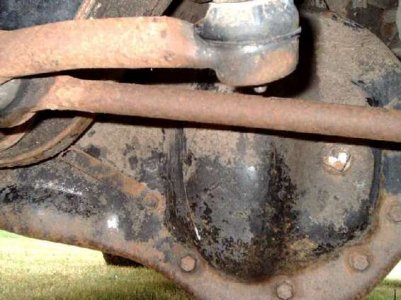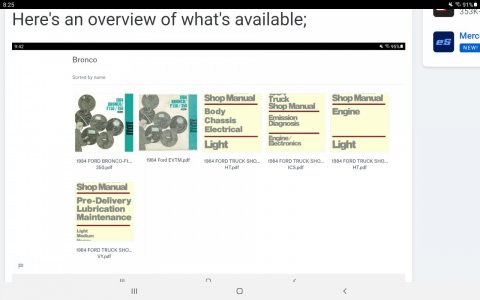You are using an out of date browser. It may not display this or other websites correctly.
You should upgrade or use an alternative browser.
You should upgrade or use an alternative browser.
1984 bronco front differential ratio?
- Thread starter Bcook
- Start date
Disclaimer: Links on this page pointing to Amazon, eBay and other sites may include affiliate code. If you click them and make a purchase, we may earn a small commission.
You'll have to look at your VIN tag in the Door jam to tell the axle ratio.
The other way to do it is to lock the front hubs and spin the tire and count how many turns of the tire turns the drive shaft 10 times.
The other way to do it is to lock the front hubs and spin the tire and count how many turns of the tire turns the drive shaft 10 times.
Yo BCOOK,
Welcome!
Here is another Dana 44 ID Tag Location pic in an 84

Source: by our late friend here in the Zone, justshootme84
It shows 3.50
●
"...Ford built our Broncos & other 4x4 trucks & vans with a numerically lower front gear ratio in the front Dana 44 than the rear so that off-road steering is enhanced.
A Bronco built with 3.55 Rear ratio would have a 3.54 ratio in the front Dana 44;
or; 3.08 in the 8.8 & 3.07 in the Dana 44;
or 4.11 in the 8.8 & 4.10 in the Dana 44, etc..."; Following was in my MS WORD Notes and the source, Randy's Ring & Pinion has removed it from their current web site; The gear ratio in the front of a four wheel drive has to be different from the front so the front wheels will pull more. There have been many different ratio combinations used in four-wheel drive vehicles, but not so that the front will pull more. Gear manufactures use different ratios for many different reasons. Some of those reasons are: strength, gear life, noise (or lack of it), geometric constraints, or simply because of the tooling they have available. I have seen Ford use a 3.50 ratio in the rear with a 3.54 in the front, or a 4.11 in the rear with a 4.09 in the front. As long as the front and rear ratios are within 1%, the vehicle works just fine on the road, and can even be as different as 2% for off-road use with no side effects. point difference in ratio is equal to 1%. To find the percentage difference in ratios it is necessary to divide, not subtract. In order to find the difference, divide one ratio by the other and look at the numbers to the right of the decimal point to see how far they vary from 1.00. For example: 3.54 ÷ 3.50 = 1.01, or 1%, not 4% different. And likewise 4.11 ÷ 4.09 = 1.005, or only a 1/2% difference. These differences are about the same as a 1/3" variation in front to rear tire height, which probably happens more often than we realize. A difference in the ratio will damage the transfer case. Any extreme difference in front and rear ratios or front and rear tire height will put undue force on the drive train. However, any difference will put strain on all parts of the drivetrain. The forces generated from the difference have to travel through the axle assemblies and the driveshafts to get to the transfer case. These excessive forces can just as easily break a front u-joint or rear spider gear as well as parts in the transfer case.
●
Here's the 1984 Bronco EVTM, Emissions, Body/Chassis, Engine and Pre-Delivery Manuals @ Bronco
Scroll down to "or continue to website" and click.
Suggest downloading all.
Here's an overview of what's available;

Partial Bronco 1984 EVTM by Ford via Gary
1984 Bronco Dealer Brochure by Ford via Gary @ 1984 Bronco
1984 Owner Guide by Ford via Gary
1984 Ford Trucks Brochure by Ford via Gary
1984 Light Truck Data Book by Ford via Gary
1984 Exterior Colors by Ford via Gary
Ford 1980-86 Pickup Fasteners by Ford via Gary
Carburetors, Chokes, & EFI - ???Gary's Garagemahal by Ford via Gary
Haynes Red Manual for 80-95 Bronco & F Series @ Hanes guide 80-96 bko f series.pdf via BroncMom
Al
Welcome!
Here is another Dana 44 ID Tag Location pic in an 84

Source: by our late friend here in the Zone, justshootme84
It shows 3.50
●
"...Ford built our Broncos & other 4x4 trucks & vans with a numerically lower front gear ratio in the front Dana 44 than the rear so that off-road steering is enhanced.
A Bronco built with 3.55 Rear ratio would have a 3.54 ratio in the front Dana 44;
or; 3.08 in the 8.8 & 3.07 in the Dana 44;
or 4.11 in the 8.8 & 4.10 in the Dana 44, etc..."; Following was in my MS WORD Notes and the source, Randy's Ring & Pinion has removed it from their current web site; The gear ratio in the front of a four wheel drive has to be different from the front so the front wheels will pull more. There have been many different ratio combinations used in four-wheel drive vehicles, but not so that the front will pull more. Gear manufactures use different ratios for many different reasons. Some of those reasons are: strength, gear life, noise (or lack of it), geometric constraints, or simply because of the tooling they have available. I have seen Ford use a 3.50 ratio in the rear with a 3.54 in the front, or a 4.11 in the rear with a 4.09 in the front. As long as the front and rear ratios are within 1%, the vehicle works just fine on the road, and can even be as different as 2% for off-road use with no side effects. point difference in ratio is equal to 1%. To find the percentage difference in ratios it is necessary to divide, not subtract. In order to find the difference, divide one ratio by the other and look at the numbers to the right of the decimal point to see how far they vary from 1.00. For example: 3.54 ÷ 3.50 = 1.01, or 1%, not 4% different. And likewise 4.11 ÷ 4.09 = 1.005, or only a 1/2% difference. These differences are about the same as a 1/3" variation in front to rear tire height, which probably happens more often than we realize. A difference in the ratio will damage the transfer case. Any extreme difference in front and rear ratios or front and rear tire height will put undue force on the drive train. However, any difference will put strain on all parts of the drivetrain. The forces generated from the difference have to travel through the axle assemblies and the driveshafts to get to the transfer case. These excessive forces can just as easily break a front u-joint or rear spider gear as well as parts in the transfer case.
●
Here's the 1984 Bronco EVTM, Emissions, Body/Chassis, Engine and Pre-Delivery Manuals @ Bronco
Scroll down to "or continue to website" and click.
Suggest downloading all.
Here's an overview of what's available;

Partial Bronco 1984 EVTM by Ford via Gary
1984 Bronco Dealer Brochure by Ford via Gary @ 1984 Bronco
1984 Owner Guide by Ford via Gary
1984 Ford Trucks Brochure by Ford via Gary
1984 Light Truck Data Book by Ford via Gary
1984 Exterior Colors by Ford via Gary
Ford 1980-86 Pickup Fasteners by Ford via Gary
Carburetors, Chokes, & EFI - ???Gary's Garagemahal by Ford via Gary
Haynes Red Manual for 80-95 Bronco & F Series @ Hanes guide 80-96 bko f series.pdf via BroncMom
Al
Similar threads
- Replies
- 36
- Views
- 3K
- Replies
- 2
- Views
- 278
Latest posts
-
-
-
-
3 dangers I found out working on my 78 bronco--and maybe yours too
- Latest: 79' Buckin Bronco
-
